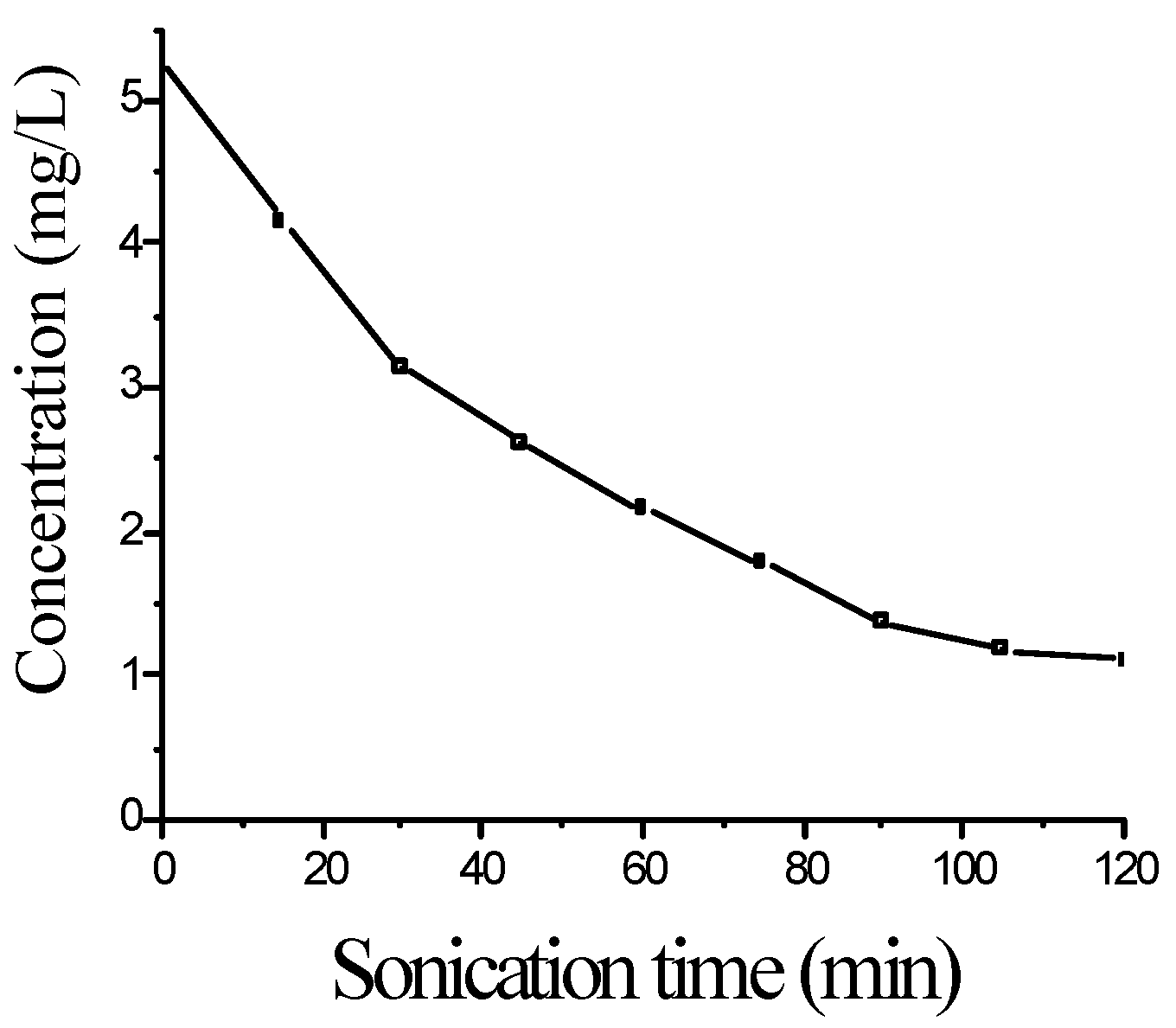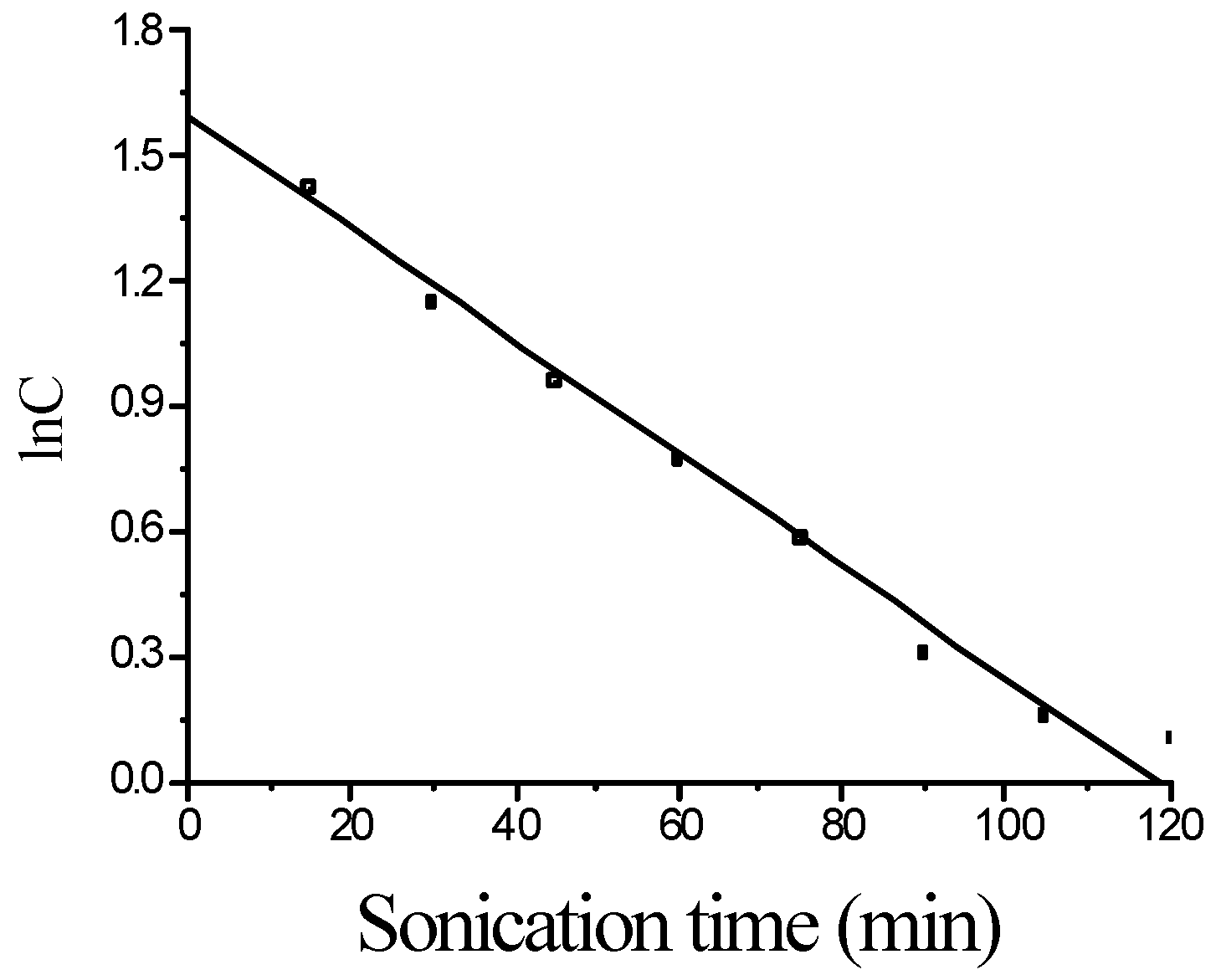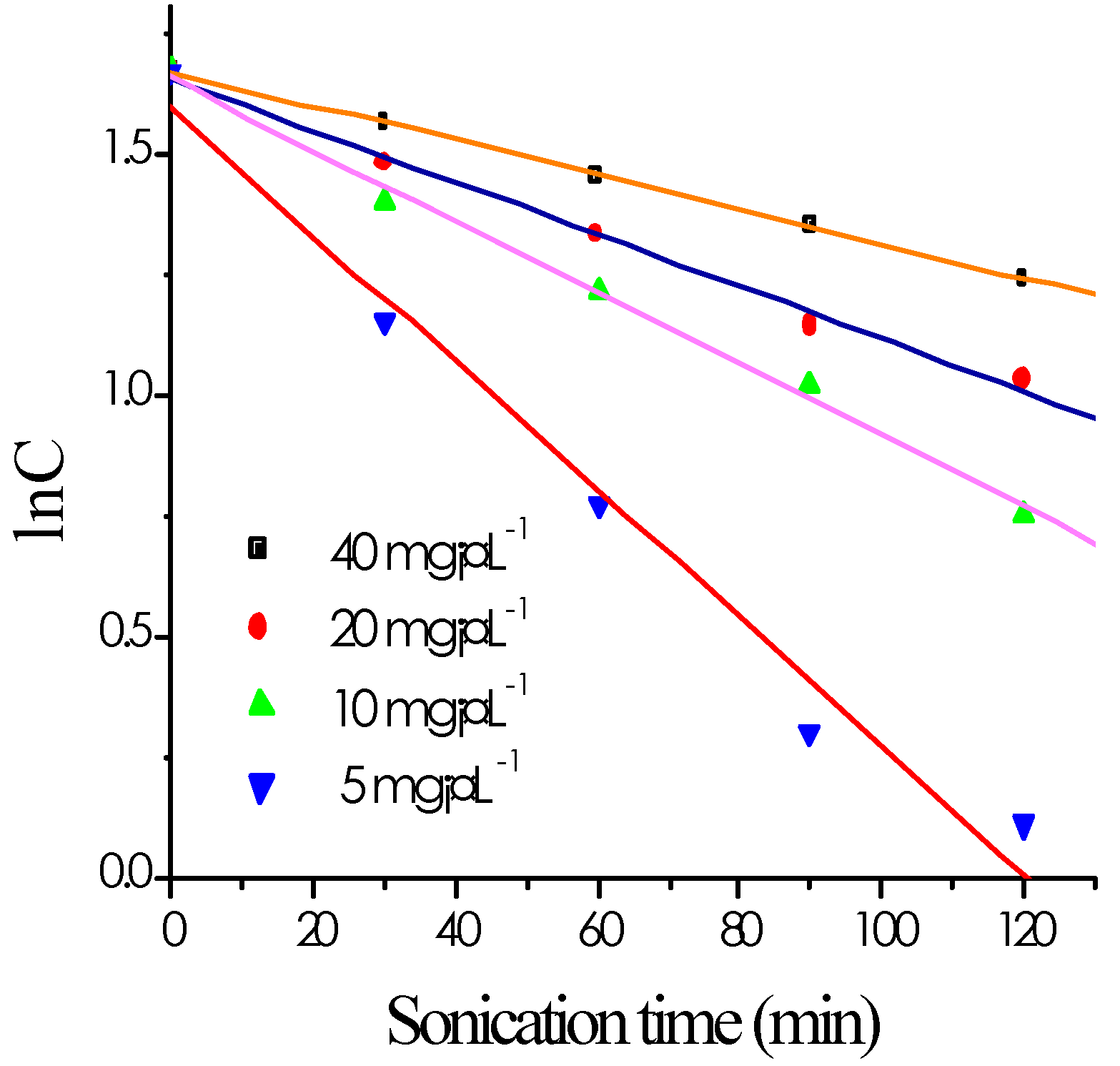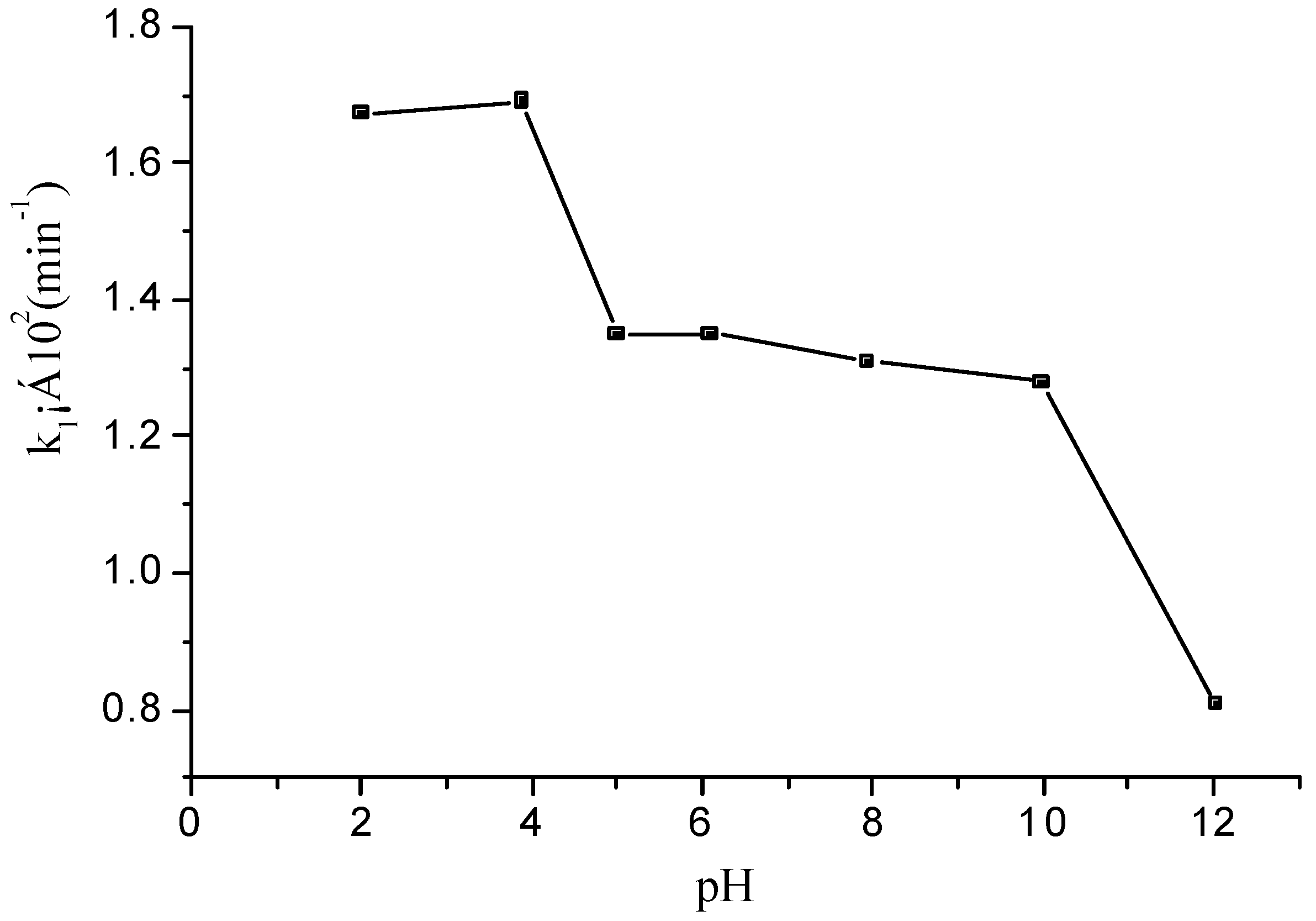Introduction
The sonochemical reaction is regarded to originate from acoustic cavitation. The cavitation processes consist of the creation, growth and implosive collapse of gas vacuoles in a solution. According to the “hot spot” theory [
1], extreme temperatures (>5000K) and high pressures (>1000atm) occur within the bubbles during cavitational collapse. Under these extreme conditions, most organic compounds decompose in the cavitation bubbles as well as compounds present in the surrounding condensed layer undergo reactions comparable to those found in high temperature combustion. The ultrasonic degradation in aqueous solution of a large number of chemical compounds of environmental interest such as 1,1,1-trichloroethane [
2], chlorinated hydrocarbons [
3,
4], polychlorinated biphenyls [
5], phenols [
6,
7] and surface active reagents [
8] have been studied. Dyes are an important kind of environmental pollutants in rivers or lakes. But the sonolysis of dye has not been reported before. In this paper we have studied the sonication of an aqueous solution of methyl violet that was chosen as a model of basic dye.
Results and Discussion
An air saturated aqueous solution of methyl violet was sonicated for 120 min. During the sonication, the concentrations of methyl violet were determined every 15 min and the ultraviolet absorption spectra of the aqueous solution of methyl violet were measured every 30 min during sonication.
Figure 1 shows the ultraviolet absorption spectra of the solution. The degradation kinetics of methyl violet are shown in
Figure 2 and
Figure 3.
Figure 1.
UV absorption spectra of aqueous solution of methyl violet at different sonication times: a. 0 min; b. 30 min; c. 30 min; d. 90 min; e. 120 min.
Figure 1.
UV absorption spectra of aqueous solution of methyl violet at different sonication times: a. 0 min; b. 30 min; c. 30 min; d. 90 min; e. 120 min.
Figure 2.
Concentration-sonication time profiles of methyl violet.
Figure 2.
Concentration-sonication time profiles of methyl violet.
Figure 3.
Degradation kinetics of methyl violet.
Figure 3.
Degradation kinetics of methyl violet.
It was found from the results that the concentrations of methyl violet in aqueous solution decreased exponentially with sonication time, indicating first-order kinetics. Regression on the experiment data delivered the first-order reaction rate coefficient (k1) is 1.35×10-2 min-1 (R= 0.993, n=8) at 20±1°C.
It was also found that the ultrasonic degradation rates of methyl violet varied with different initial concentrations.
Figure 4 shows the degradation kinetics of methyl violet for different initial concentrations at 20°C. It was observed that as the initial concentrations increased, the degradation rate coefficients decreased. The ultrasonic degradation rate coefficients (
k1) of methyl violet were 1.32×10
-2 (r=0.990, n=5), 7.39×10
-3 (r=0.997, n=5), 5.42×10
-3 (r=0.997, n=5) and 3.57×10
-3 (r=0.999, n=5) min
-1 at initial concentrations 5.0, 10.0, 20.0 and 40.0 mg L
-1, respectively.
Figure 4.
Degradation kinetics of methyl violet for different initial concentrations at 20°C.
Figure 4.
Degradation kinetics of methyl violet for different initial concentrations at 20°C.
Figure 5.
The influence of temperature on the ultrasonic degradation rate of methyl violet.
Figure 5.
The influence of temperature on the ultrasonic degradation rate of methyl violet.
The influence of the temperature of the reaction solution on the ultrasonic degradation of methyl violet was investigated and the results are shown in
Figure 5. It was found that the ultrasonic degradation rate coefficients
(k1) of methyl violet were 1.35×10
-2, 1.32×10
-2, 1.28×10
-2 and 5.10×10
-3 min
-1 at temperature 20±1°C, 30±1°C, 40±1°C and 80±2°C, respectively. The results show that the ultrasonic degradation rate was almost invariable at temperature 20-40°C, but the ultrasonic degradation rate was decreased remarkably when the temperature of the solution rose to 80°C. It has been reported that three different regions are formed in the aqueous sonochemical process [
9]: (1) The gas phase within the cavitation bubble where elevated temperature and high pressure are produced, (2) The interfacial zone between the bubble and the bulk solution where the temperature is lower than that inside the bubble but still high enough for a sonochemical reaction. (3) The bulk solution at ambient temperature where reaction still takes place. Of the aforementioned three regions, we prefer the interfacial zone as the region where methyl violet was destructured because of the low vapor pressure of the compound. So the influence of temperature of the reaction solution on the ultrasonic degradation is not remarkable at temperature 20-40°C. When the temperature of the solution rose to 80°C, the number of cavitation bubbles were reduced remarkably and the ultrasonic degradation rate of methyl violet was decreased.
The influence of the acidity of the reaction medium on the ultrasonic degradation of methyl violet was also studied and the results are shown in
Figure 6. During sonication the buffers limited the pH-variation to less than 0.4 pH-unit. So there is an influence of pH on the degradation rate of methyl violet. It was found that the ultrasonic degradation rate coefficients (
k1) of methyl violet in acidic water(pH 2-4) are higher than those obtained in neutral aqueous solution (pH 5-10) and the
k1 obtained at basic medium (pH>10) are the lowest.
Figure 6.
The influence of the acidity of reaction medium on the degradation of methyl violet.
Figure 6.
The influence of the acidity of reaction medium on the degradation of methyl violet.









